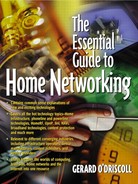HYBRID FIBER-COAX (HFC) TECHNOLOGIES
Hybrid fiber-coax (HFC) technology refers to any network configuration of fiber-optic and coaxial cable that may be used to redistribute a variety of broadband entertainment services. These broadband services include telephony, interactive multimedia, high speed Internet access, video-on-demand, and distance learning. The types of services provided to consumers will vary among cable companies.
Many of the major cable television companies in the United States, Europe, Latin America, and Southeast Asia are already using it. Networks built using HFC technology have many characteristics that make it ideal for handling the next generation of communication services. First and foremost, HFC networks can simultaneously transmit broadband analog and digital services. Additionally, HFC meets the capacity and reliability requirements of new digital data services. HFC's expandable capacity allows network operators to add services incrementally without major changes to the overall plant infrastructure. HFC is essentially a "pay as you go" architecture that matches infrastructure investment with new revenue streams, operational savings, and reliability enhancements. The HFC network architecture consists of fiber transmitters, optical nodes, coaxial cables, and distribution hubs. The architecture of an HFC system required to deliver data services to a home network is illustrated in Figure 3.2.
From the diagram, we can see that the signal is transmitted from a central location in a star-like fashion to the fiber nodes using fiber-optic feeders. The fiber node, in turn, distributes the signals over coaxial cable, amplifiers, and taps throughout the customer service area. The size of the customer service area can range from 500 to 2000 home networks.
HFC networks are two-way systems that are capable of communicating with a home network at speeds of 40 Mbits per second and above. To achieve these high speeds, a signal leaving the network operator's premises needs to be compressed and modulated using a technique called QAM (Quadrature Amplitude Modulation). This method of formatting a signal improves the rate at which information can be broadcast over the HFC network to the home network.
Figure 3.2. Architecture of a typical HFC network

For cable companies, the combination of HFC with home networking technologies is expected to be the next big money spinner. Income sources will come from installations, equipment rentals, and service support. Additionally, many of the senior executives in the cable TV industry are planning to generate huge profits through the provision of value-added interactive TV applications. For example, Canada's largest operator, Rodgers Cablesystems, is rolling out home data networks to its subscriber base. This lead is expected to be followed in the near future by other large cable operators such as AT&T, Cox Communications, and Time Warner.
